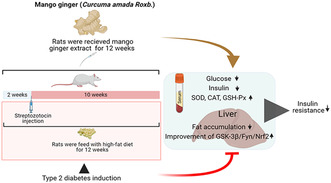- Record: found
- Abstract: found
- Article: found
Mango ginger ( Curcuma amada Roxb.) may alleviate the effect of high‐fat diet/streptozotocin‐induced diabetes by activation of the GSK‐3β/Fyn/Nrf2 pathway

Read this article at
Abstract
Mango ginger (MG) exhibits antioxidant, anti‐inflammatory, and antihyperglycemic effects; however, the exact mechanism of action of MG extract in relation to its antidiabetic properties remains unclear. To investigate the potential antidiabetic effect of MG extract, we used a high‐fat diet (HFD)/low‐dose streptozotocin (STZ)‐induced type 2 diabetic rat model. A total of 28 male Wistar rats were randomly divided into four groups: (i) Control, (ii) MG (50 mg/kg/day of MG extract), (iii) HFD + STZ (40 mg/kg i.p.), and (iv) HFD + STZ + MG. Following a 12‐week administration of MG extract, significant reductions were observed in serum glucose, insulin, free fatty acid, cholesterol, and triglyceride levels in diabetic rats ( p < .0001 for all). MG extract supplementation led to an increase in the total antioxidant capacity of the serum and a decrease in malondialdehyde (MDA) levels in both the serum and liver ( p < .0001). Furthermore, hepatocellular fat accumulation was partially attenuated in the HFD + STZ + MG group. Notably, MG extract inhibited glycogen synthase kinase‐3β (GSK‐3β) in the liver ( p < .01) and downregulated Fyn expression, resulting in elevated nuclear factor erythroid 2–related factor 2 (Nrf2) activity in the HFD + STZ + MG group compared to the HFD + STZ group ( p < .05). The increased activity of Nrf2 in the HFD + STZ + MG group likely promoted the upregulation of heme oxygenase 1 (HO‐1) in the liver ( p < .0001). In conclusion, MG extract may exert antidiabetic effects by augmenting the antioxidant defense system through the regulation of GSK‐3β/Fyn/Nrf2 in a rat model of type 2 diabetes.
Abstract
Related collections
Most cited references55
- Record: found
- Abstract: found
- Article: not found
IDF Diabetes Atlas: Global, regional and country-level diabetes prevalence estimates for 2021 and projections for 2045
- Record: found
- Abstract: found
- Article: not found
Inflammation in obesity, diabetes, and related disorders.
- Record: found
- Abstract: found
- Article: not found
